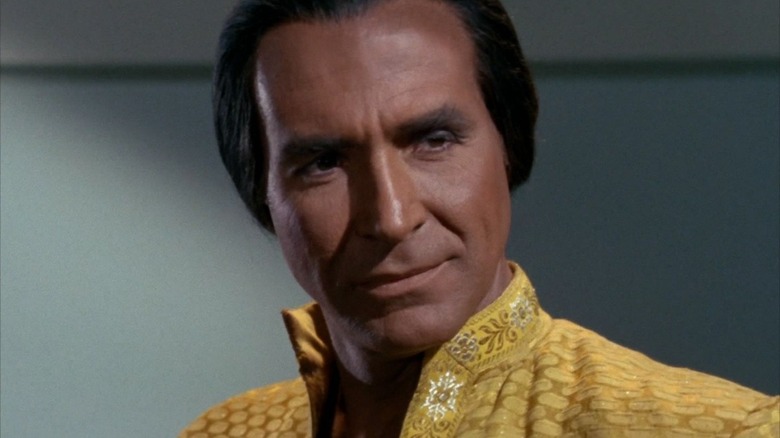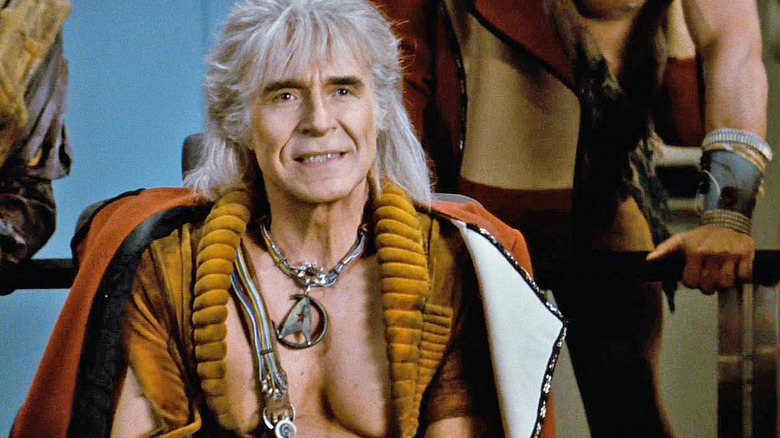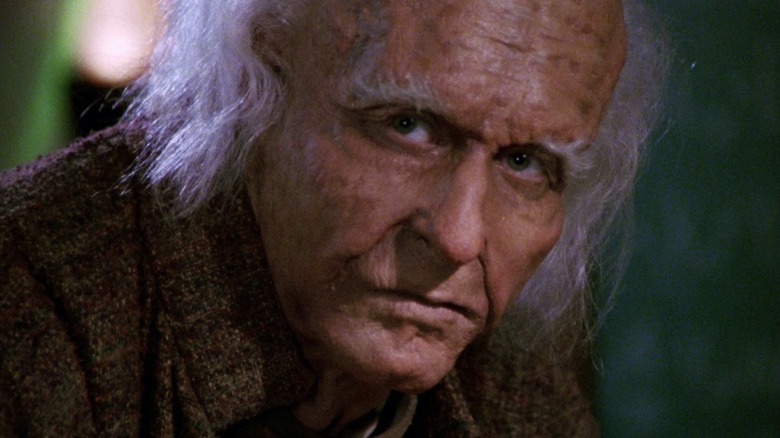Gene Roddenberry Used Star Trek's Khan To Send A Hidden Message
The "Star Trek" episode "Space Seed" (February 16, 1967) may be, to modern audiences, a little fraught. "Space Seed" introduced the character of Khan Noonien Singh (Ricardo Montalbán), a former Earth despot who was found cryogenically frozen on board a drifting space vessel. Khan had been frozen for 200 years, having fled Earth after the vicious Eugenics Wars of the 1990s. Khan, you see, was a genetically enhanced soldier who conquered more than a quarter of Earth from 1992 to 1996, then was ousted and deposed and forced to flee into space. He was "the last of the tyrants to be overthrown."
When revived, Khan proves to be charming and confident, to a degree that the Enterprise crew finds appealing. Although a despot, Captain Kirk (William Shatner) notes that Khan was "the best of the tyrants," explaining to Spock (Leonard Nimoy) that admiring dictators, however gross, is a natural human impulse. Scotty (James Doohan) admits out loud that he admires Khan. Spock (Leonard Nimoy) is appalled. The audience likely is too. Did Kirk, a man ostensibly devoted to peace and strength of character, admit that it's natural and okay to look up to dictators?
According to StarTrek.com, the writer of "Space Seed" initially envisioned Khan to be an Icelandic Viking named Harald Erickson, an ordinary criminal. After many changes to the script, the character eventually came to be named Sibahl Khan Noonien, as show creator Gene Roddenberry specifically dictated. Montalbán was cast in the role, and Khan's country of origin shifted from Iceland to India. The name eventually became Khan Noonien Singh.
It seems there was a reason that Roddenberry wanted to name the character "Noonien." He was trying to alert an old buddy named Noonien that he had lost contact with years earlier.
Khaaaaaaaan!
Another article in StarTrek.com noted that Khan's name be changed from Sibahl Khan Noonien like Roddenberry wanted to Govin Bahadur Singh; it seems the show's research firm, the DeForest Research Company, found their name to be more in line with Sikh traditions. Roddenberry, however, insisted on "Noonien" being part of the name, and he got his way. If one can find the earliest novelizations of "Star Trek," one will see that the "Space Seed" book still named the character Sibahl Khan Noonien. The character's final name, "Khan Noonien Singh," was a marriage between the old name and the suggested name.
A 2013 Gizmodo article repeated an oft-repeated story known to deep-cut Trekkies out that "Noonien" was taken from a real person name Noonien Wang.
Noonien Wang was, by Gizmodo's description, a friend of Roddenberry's that he met in the 1940s while in China. During World War II, Roddenberry (as described in David Alexander's biography "Star Trek Creator") served as a pilot for the Air Force's 394th Bomb Squadron. Roddenberry enlisted in 1941 and stopped flying international missions in 1943 after he crashed a plane. Where he met Noonien Wang is unknown, but the two had become friends at some point during this period. Roddenberry and Wang, however, lost contact after the war, and Roddenberry still wanted to reconnect by the 1960s.
He changed the name of his villain character to "Noonien" hoping that when "Space Seed" aired in China, his old friend would put together that the series was created by Roddenberry, and that "Khan Noonien Singh" was a signal to get his friend to contact him. Evidently — long before social media or exhaustively comprehensive phone books — getting personal information was difficult, and this was the best way Roddenberry could think of to contact Noonien Wang.
Evidently, it didn't work.
Khaaaaaan?
By the time Roddenberry made "Star Trek: The Next Generation" in 1987, he was still dropping clues into his show, hoping that Wang would notice. On "Next Generation," the android Data (Brent Spiner) was created by a character named Dr. Noonien Soong. Any Trekkies who have ever wondered why Khan Noonien Singh and Dr. Noonien Soong have such similar names know that they were both named after the same person.
There has been some light debate among Trekkies, however, as to whether or not Noonien Wang — sometimes Kim Noonien Wang — was a real person or not. Some have said that Roddenberry may have accidentally mistaken the name Noonien for the name Nguyen. Others have heard that the missing person in question was actually named "Kim Noonien Singh." Since Roddenberry never reconnected with Wang, one cannot be 100% sure. There is, however, no direct evidence to refute that Roddenberry was trying to find an old wartime friend.
More fun are the links between Khan to Dr. Soong through canonical "Star Trek" means. It was revealed in "Star Trek: Enterprise" that an ancestor of Dr. Noonien Soong — named Arik Soong — was also keen on genetic manipulation, and was singlehanded responsible for splicing "enhanced" human DNA into Klingons, making them look more human during the time of the original "Star Trek" series. In "Star Trek: Picard," an even earlier Soong ancestor — Adam Soong — was revealed to be working on a Khan project as early as 2024. This was after the Eugenics wars had been time-shifted forward from the '90s, a discrepancy eventually covered in an episode of "Star Trek: Strange New Worlds." A character on that show is named La'an Noonien-Singh (Christina Chong), Khan's granddaughter.


